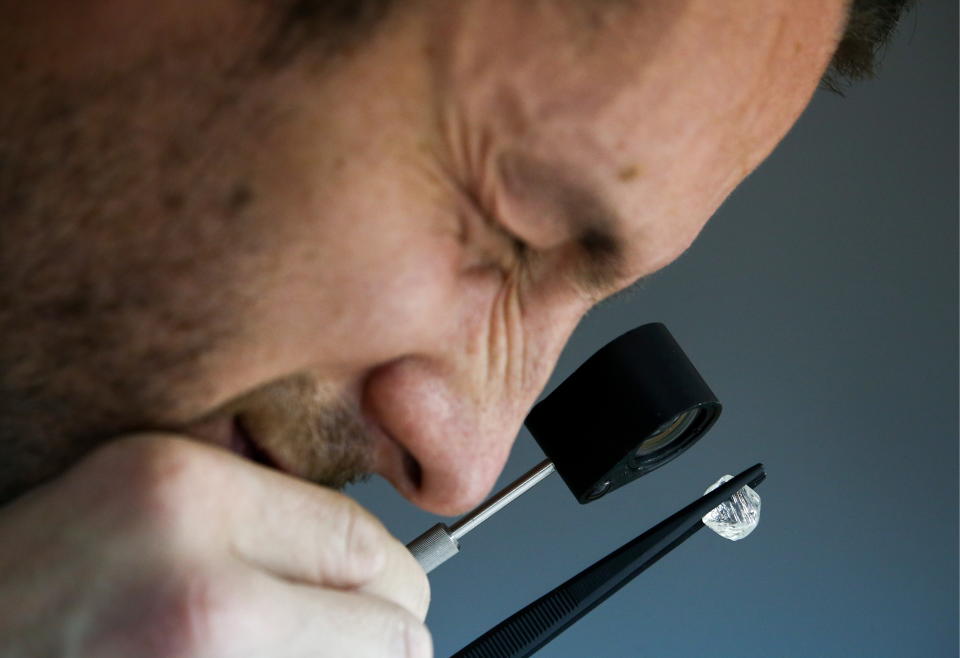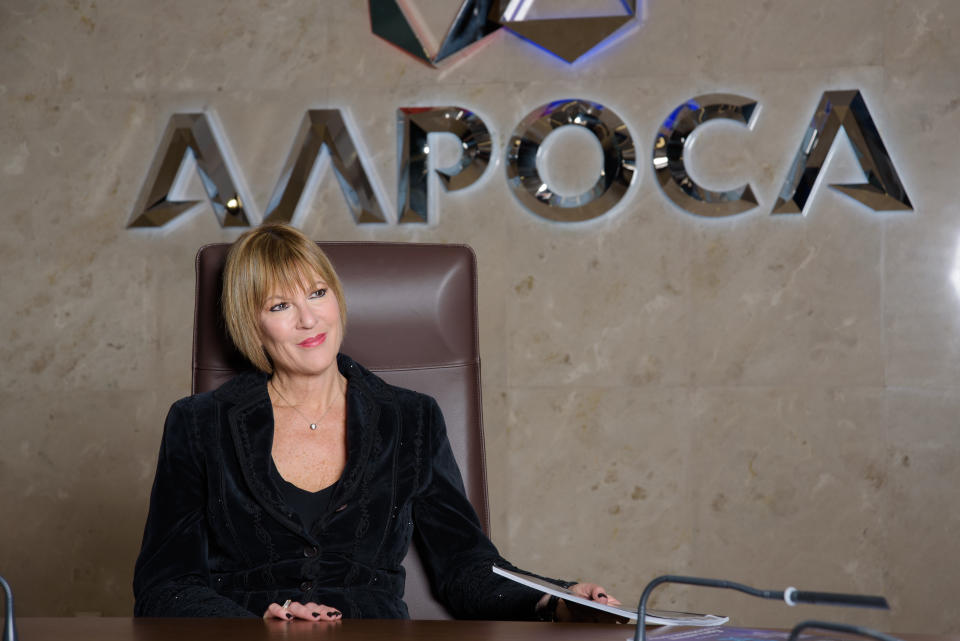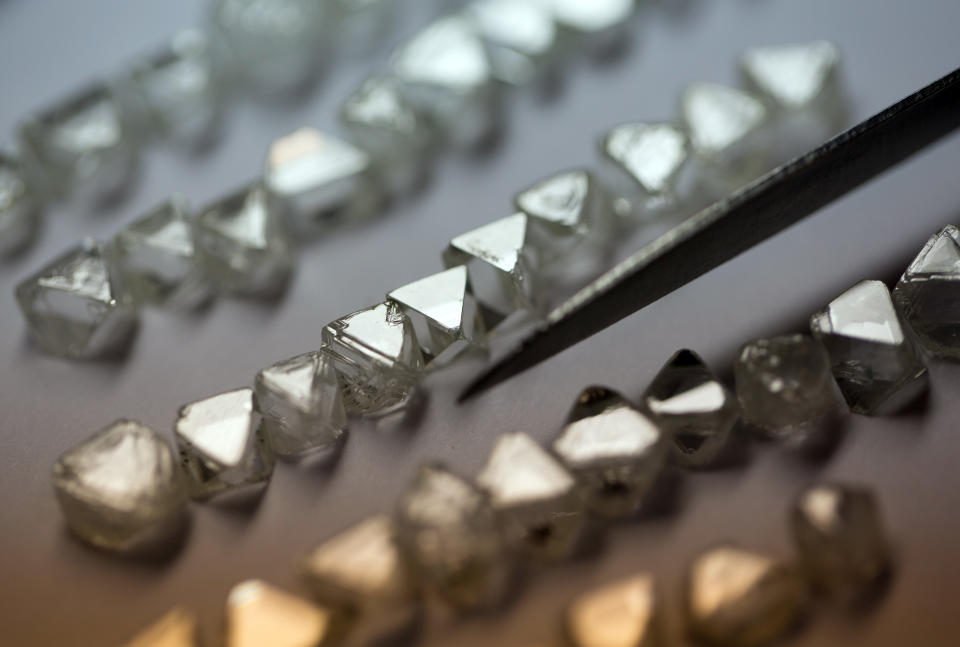Russian diamond giant hopes politics won't wreck US expansion plans
The Russian diamond giant Alrosa, which mines more diamonds than any other company in the world, is starting a big sales push in America.
The company reopened its US operations in 2018 after they lay dormant for two years and hired industry veteran Rebecca Foerster in January to lead the division.
In an exclusive first interview since joining the company, Foerster said she doesn’t believe the negative headlines surrounding the US-Russia relationship will have any bearing on Alrosa’s opportunities in the world’s largest diamond market.
“My belief is that the two things are extremely separate. When we’re talking about a diamond and the beauty of a diamond, it’s not political,” Foerster, president of Alrosa North America, told Yahoo Finance UK.
“With Russia, if we talk about caviar or vodka or beautifully Russian-cut diamonds, I don’t think that the political aspect inserts itself into the consumer’s perception of those goods. I don’t see that to be a barrier to entry at all,” she said.
The US has imposed targeted sanctions on Russian individuals and businesses over the past few years to punish Russia for its aggression against Ukraine and involvement in the Syrian conflict.

The move slammed some Russian metal and energy companies, along with banks. But the diamond industry has avoided attention.
“Fortunately, there has been no discussion of putting restrictions on the diamond business,” Alrosa said in a written statement to Yahoo Finance UK, but noted the threat of sanctions “is quite unpredictable.”
“We have developed several scenarios in advance, in case of the introduction of any restrictions on the company’s activities,” it said.
Alrosa (ALRS.ME) produces close to 40 million carats of diamonds annually from its Russian mines, or about 27% of the global total. That’s 18% more than its closest competitor, De Beers, which is owned by mining giant Anglo American (AAL.L).
But Alrosa doesn’t have name-brand recognition like De Beers because it doesn’t market directly to consumers. Its diamonds tend to be lower quality gems that sell for less per carat than De Beers.
Alrosa also makes less money: $4.2bn (£3.2bn) in 2017 versus about $6bn (£4.6bn) at De Beers.
Staying out of the public eye
The new US sales strategy will see Alrosa remain out of the public eye. It’s not opening any stores, planning splashy ad campaigns or crafting its own engagement rings.
It’s focused instead on growing its American client base of manufacturers and retailers that want to buy its polished diamonds, in addition to the rough diamonds it already sells.
The expectation is these stones will end up in American jewellery.
Foerster said American consumers will be motivated to buy Alrosa diamonds because the company has a reputation for conflict-free, sustainable Russian mines and a world-class system for tracking its gems.

More than half of global diamond demand comes from the US, and it’s the fastest growing market in the world with 4% annual growth, according to De Beers. Americans buy more than $40bn ($31bn) in diamonds each year.
Alrosa has a tiny stake, with sales of just $14m to US-based clients in 2018.
Its also has separate diamond auctions which launched in New York last year, which brought in $19m from international buyers.
Foerster said they’re starting from a low base but she’s looking to double US activity annually over the next few years, with more high-profile auctions and clients.
READ MORE: Russians hold more gold as sanctions bite
Tiffany (TIF) and Signet Jewelers (SIG) are already customers of Alrosa’s rough diamonds, but haven’t signed up to buy polished diamonds yet.

Looking for something unique
Alrosa produces more than 7,000 carats of coloured diamonds per year, and demand for these kinds of diamonds has been growing in the US.
“We can capitalise on that trend,” Foerster said.
“We have a nice variety of natural coloured diamonds and [we have the] ability to cut and polish fancy shaped diamonds. These are becoming more and more of interest to the US consumer. Especially bridal consumers wanting to express their individuality,” she said.
The synthetic risk
The growth of synthetic diamond production, alongside increasing consumer acceptance, presents a real risk to Alrosa’s plans.
Alrosa is known for less expensive, smaller diamonds and this is “the first segment of natural diamonds that will be hit,” warns Edahn Golan, an independent diamond industry analyst.
“Its production is really threatened by lab-grown diamonds,” he told Yahoo Finance UK.
READ MORE: Are lab-grown diamonds the future?
Foerster admits that the challenge presented by synthetic diamonds is something that keeps her up at night.
“It’s very important from an industry perspective that we become very strong and efficient in making sure that the consumer understands the difference between a lab-grown diamond and a mined diamond,” she said.
Foerster believes consumers ultimately value the story behind mined diamonds, with information readily available about their place of origin and the millions of jobs that these stones support.
Alrosa, which employs about 37,000 workers, said it offers good wages, with Russian workers making three times the average national salary.
The diamond mining industry plays a major role in lifting depressed regions out of poverty.
“Diamonds provide livelihoods for literally millions of people around the world,” said Golan, noting that diamond miners are generally very good corporate citizens.
When it comes to customers’ environmental considerations, it’s not clear-cut whether synthetic or natural diamonds are more eco-friendly, said Golan. Miners don’t always have a perfect reputation in this area, but the lab-grown diamond industry uses a huge amount of energy and is known for poor working conditions, he said.
Foerster said Alrosa, and the industry as a whole, are very conscious of environmental issues.
“It is a misconception that the diamond mining industry today does permanent damage to our earth and leaves the environment in bad condition … A big part of mining is the sustainability factor,” she said.

 Yahoo Finance
Yahoo Finance 